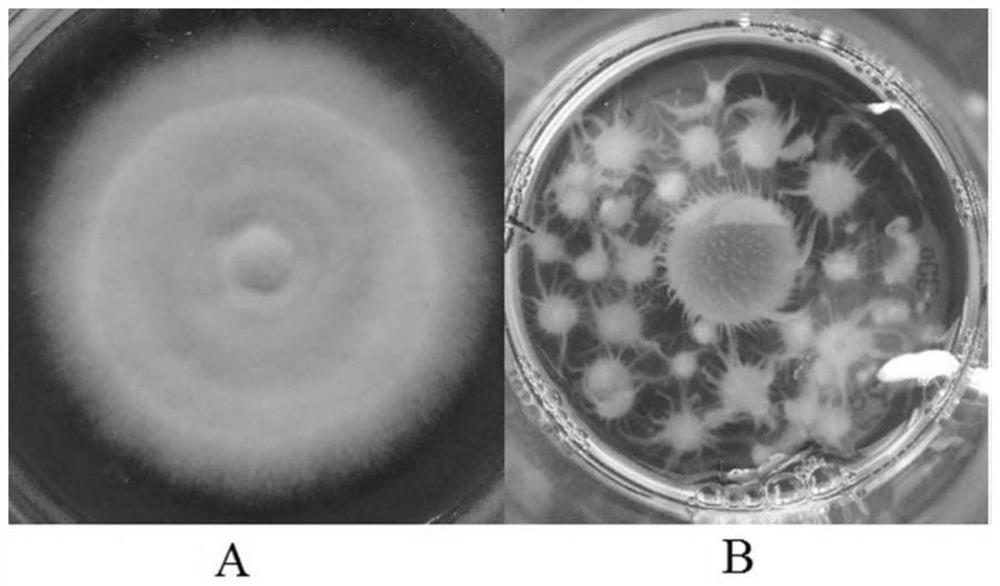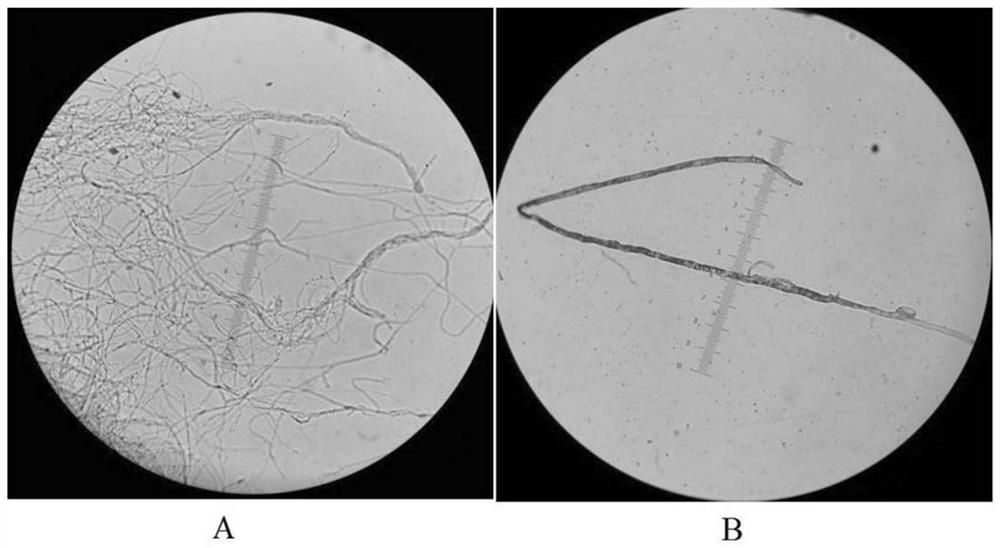A kind of Pseudomonas dispora strain and its breeding method
A technology of A. bisporus and a strain, which is applied in the field of A. bisporus strains and their breeding, can solve problems such as less research on A. bisporus, and achieves consistent development, stable quality and high quality Good results
- Summary
- Abstract
- Description
- Claims
- Application Information
AI Technical Summary
Problems solved by technology
Method used
Image
Examples
Embodiment 1
[0045] (1) Strain isolation
[0046] Choose mushrooms without umbrellas and stalks without cracks, and discard young mushrooms eaten by ants and fruit fly larvae. After wiping the fruiting bodies of young mushrooms with sterile paper or cotton, use sterile tweezers to pick out the internal hyphae, place them in PDA medium containing streptomycin, and cultivate them at 26°C for 7 days. Colonies with high whiteness, uniform density everywhere, and no bacterial contamination around.
[0047] (2) strain purification
[0048] Pick the aerial hyphae in the target colony from the colonies selected in step (1) and insert them into fresh PDA medium to purify the strains, and transfer the strains after 3 times of purification into inclined test tubes, Cultivate at 24°C to 26°C until the slope is covered with hyphae to obtain pure strains for strain preservation. Mycelial morphology and culture characteristics such as figure 1 shown.
[0049] figure 1 A shows that the mycelium of P...
Embodiment 2
[0057] (1) Fermented cultivation material
[0058] Weigh cottonseed husks, the raw material for cultivation, add water and mix well, fully stir with a mixer during adding water to make it fully absorb water, then add an appropriate amount of lime water and mix well to make the pH value 8.0, build a heap and ferment for 8 days, remove The gossypol in the cottonseed shell increases the water holding capacity of the material and softens the material.
[0059] Preparation of solid medium: 85.2% of fermented cottonseed hulls, 10.2% of wheat bran, 2.6% of glucose, 0.3% of magnesium sulfate, 1.2% of potassium dihydrogen phosphate, and 0.5% of calcium carbonate; the water content is 60% to 75%, and the pH is natural Weighing the solid culture medium according to the ratio of parts by mass, adding water and mixing well, fully stirring with a mixer during adding water to make it fully absorb water, adjusting the water content of the solid culture medium to 68%, and pH 8.5.
[0060] (2)...
Embodiment 3
[0092] The pure mycelia obtained in the step (2) of Example 1 was inoculated onto the medium I (malt extract 5g / L, maltose 10g / L, yeast extract 2.5g / L, ammonium sulfate 0.5g / L, sulfuric acid Magnesium 1.7g / L, potassium dihydrogen phosphate 1g / L, dipotassium hydrogen phosphate 1g / L, agar 20g / L, distilled water to 1000mL, pH natural), at 20°C, 22°C, 24°C, 26°C , 28°C and 30°C for 7 days at a constant temperature and protected from light, measure the diameter of the colony, and calculate the daily average growth rate. The result is as Figure 7 As shown, it can be seen that Oddya bisporus can grow in the temperature range of 20°C to 30°C, and the growth rate is the fastest at 26°C, and the optimum growth temperature range is 24°C to 26°C, which is lower than the temperature range of 26°C. The hyphae of O. bisporus grow slowly at 22℃ and higher than 28℃.
PUM
| Property | Measurement | Unit |
|---|---|---|
| length | aaaaa | aaaaa |
| diameter | aaaaa | aaaaa |
| diameter | aaaaa | aaaaa |
Abstract
Description
Claims
Application Information
 Login to View More
Login to View More - R&D
- Intellectual Property
- Life Sciences
- Materials
- Tech Scout
- Unparalleled Data Quality
- Higher Quality Content
- 60% Fewer Hallucinations
Browse by: Latest US Patents, China's latest patents, Technical Efficacy Thesaurus, Application Domain, Technology Topic, Popular Technical Reports.
© 2025 PatSnap. All rights reserved.Legal|Privacy policy|Modern Slavery Act Transparency Statement|Sitemap|About US| Contact US: help@patsnap.com



